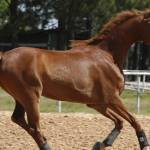The History of the American Saddlebred

Like many of today’s popular riding horses, the American Saddlebred combines the best traits of a number of older breeds. Some of the Saddlebred’s gaited talents were passed down by Galloway pacing horses brought to America by British colonists in the 1600s. Crossed with Thoroughbreds in the early 1700s, these small pacers produced somewhat taller offspring with improved stamina. The outstanding Thoroughbred stallion Messenger was imported in 1788 and was influential in improving the Thoroughbred breed while contributing his animated movement and trotting ability to both the developing Saddlebred horse and another new breed, the Standardbred.
By the late 1700s, a unique type of horse was emerging for multiple uses including riding, driving, and military use. Cavalry mounts were frequently horses of Saddlebred type during both the Revolutionary War and the War of 1812. These so-called American Horses continued to be crossed with Thoroughbreds and other horses, with breeders emphasizing comfortable gaits and a stylish way of going.
Though American Horses moved west with settlers in the 1800s, Kentucky became the center of fine riding horse production after the War of 1812, and the first recorded horse show for this type of horse took place in Lexington, Kentucky, in 1817. Two important sires, Gaines’ Denmark and Harrison Chief, came into prominence in the mid to late 1800s, and both have been designated foundation sires of the Saddlebred breed.
After the Civil War, interest grew in the formation of a breed registry. At a meeting in 1891 in Louisville, Kentucky, the American Saddle-Horse Breeders’ Association became the first horse breed association in the United States. Some breeding records had been kept by individuals prior to this time, but under the new organization, pedigrees were collected and recorded. The name of the organization was changed in 1980 to the American Saddlebred Horse Association.
Saddlebreds were versatile performance horses, able to do many tasks with speed, strength, and style. They were driven in harness, used as military mounts, and ridden as pleasure horses. All Saddlebreds could perform a walk, trot, and canter. Some individuals also showed a natural talent for two unique gaits: the rack, a fast and flashy four-beat gait, and the slow gait, a slower version that is exceptionally smooth for the rider. Horses began to be selectively bred to emphasize their particular talents, and specific horses emerged as breed leaders that could pass on the most prized traits.
As these horses became more popular and plentiful, professional breeders and trainers in Kentucky, Missouri, and other states competed at shows to claim the top honors with their horses. The first World’s Grand Championship for Saddlebred horses was hosted by the Kentucky State Fair in 1917, where Easter Cloud was named five-gaited champion, Happy Sybil was the three-gaited champion, and Lady Beautiful took first prize in the fine-harness division. Some outstanding horses throughout the 1900s included Bourbon Chief, Sweetheart on Parade, Wing Commander, My My, Imperator, and Lady Carrigan.
Traditional classes are still held to award the title of World’s Grand Champion for Saddlebred horses, but many Saddlebreds in the 21st century have come full-circle and are shown in a number of disciplines that reflect the talents of their multibreed ancestry. Saddlebred horses have competed successfully in dressage, cutting, reining, barrel racing, jumping, endurance riding, combined driving, and eventing, among other pursuits.








